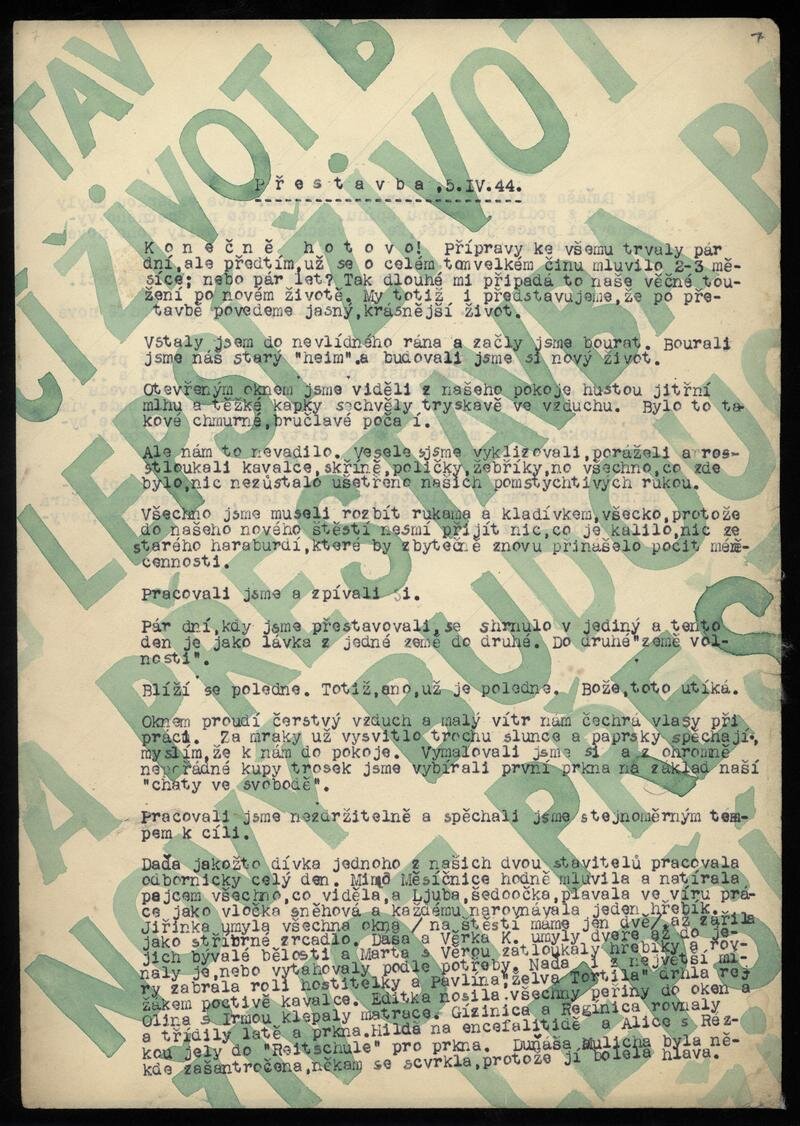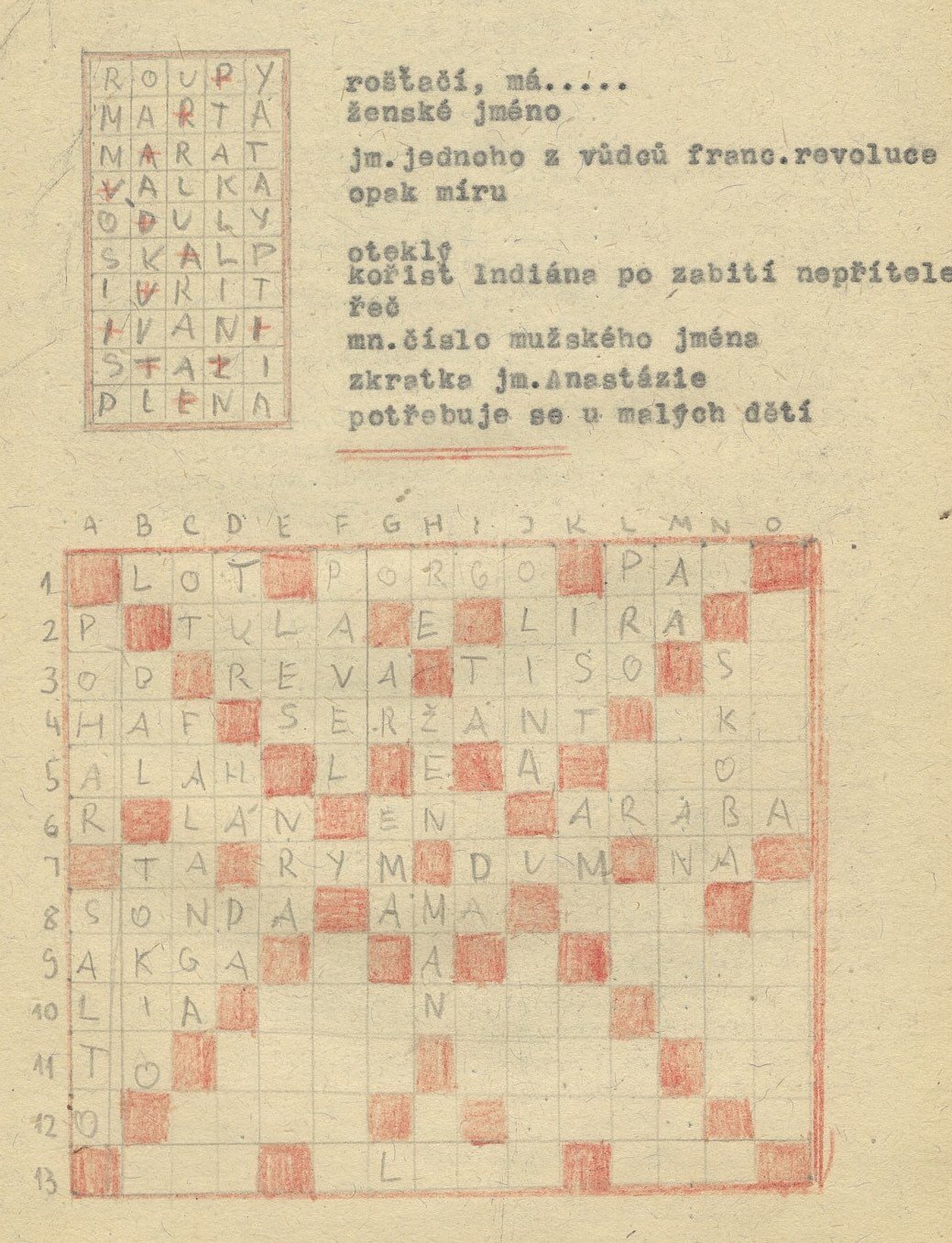
WHAT IS rim rim rim?
Rim Rim Rim was an underground handmade magazine – or zine – that was published by teenage boy prisoners of the Terezin Ghetto from February 1944 to September 1944. The magazine title Rim Rim Rim was derived from a cheer its creators, who called themselves “Nešarim” (“the Hawks”) and would shout “Rim, Rim, Rim, long live Nešarim!”

WHY WAS RIM RIM RIM CREATED?
“Dear readers! Don't take our magazine too critically. You may like Nešar or Seven Leaves better, but consider that they already have the contributions of other boys. Our magazine has set itself the task of combining the properties of the other two. It should be both fun and informative. You have to help us with your contributions. We hope that you will give us enough of them and that we will be able to compile more numbers from them. Sincerely, RIM RIM RIM Send us contributions to Nešarim!”
Rim Rim Rim was the third publication to be launched by the Jewish boy prisoners of Room #7 in Terezin Building L417, following Seven Leaves and Nešar. The publication was founded as an effort by its creators to create the room’s best magazine by combining the best journalistic aspects of Seven Leaves and Nešar.

WHO WROTE FOR RIM RIM RIM?
“There was a group of children. They were split up according to age. They came up in different social classes – some were orphans brought up in institutions, some were from large families, some were only children. Athletes and intellectuals. Strong and weak. From the city and from the countryside. Boys who were full of life and accustomed to the company of others, and boys who were lonely children.”


Rim Rim Rim was created by about 20 of the 12-to-16-year-old boys who lived in Room #7 in Terezin Building L417, which housed Jewish boy prisoners and where five other zines were produced. The magazine was actually the third publication produced by the boys of Room #7, following Seven Leaves and Nešar, and its founding set off an editorial competition, especially between Rim Rim Rim and Nešar. Some of the writers signed their full names or by their initials, but most used nicknames.

-
Pavel Lion
-
P. “Koko” Heller
-
Pavel “Pauli” Götzlinger
-
Jan Hermann
-
Gustav “Tuti” Zweig
-
Jan “Blecha” Bloch
-
Jan “Gorilla” Strebinger
-
Jiří “Iski” Lekner
-
Pavel “Pajík” Weiner
-
Josef Bäumel
-
Hanuš Brenner
-
Rudolf Kopperl
-
Petr “Pedro” Lederer
-
Jiří Mautner
-
Gabriel “Eli” Mühlstein
-
Godit Palko
-
Jiří “ Kikina” Repper
-
Francis “Franta” Maier

“What will happen to me?
This is a difficult problem, everyone is a dream.
Perhaps, perhaps I will become rich,
I will conquer the whole world,
Perhaps I will be an inventor, a chemist, a groom.
About everything I can only dream of,
I only dream about it all.
I see a long, endless path in front of me,
Each milestone indicates age, each milestone marks a year.
An old, poor woman walks slowly but surely,
Along the road that is bolted to the milestones.
The woman thinks and counts,
How many milestones she still lacks,
Towards the end of life, towards its goal.
And when I find her, I'll look at her too.
I don't know what will happen to me, but I'm not worried.
Because I know one thing.
That everyone who’s born
Would die after that.”
– Jan Strebinger

WHERE WAS rim rim riM PUBLISHED?
“The Rim editorial staff asks their contributors to write their contributions not too densely and legibly. If one of them is short of paper, he can get it from the newsroom.”
The zine was produced in Room #7 of Terezin’s Building L417 which housed Czech Jewish boys. The boys’ counsellor was Franta Maier, who was lauded by the boys for his morals, ethics and positivity. Maier preached respect for one another. “The boys’ first duty is to survive, the second is to respect their parents, and the third is to be prepared for life,” Maier said. “Later, when I heard the breathing of all the forty boys as they slept, I asked myself, ‘What will happen tomorrow?’ And I cried.”

Meanwhile, the competition between Rim Rim Rim and Nešar was fierce and took on the characteristics of a sporting match, where critiques were harsh, perceived victories were celebrated and apparent losses were mourned. All three magazines competed for both readers and writers, who switched allegiances depending on how they got along with fellow scribes.

“It annoys me that Rim Rim Rim already has everything written. We have to do it!... I'm still overwhelmed by Rim Rim. It still flashes before my eyes. I don't know how to handle it. I think it's the biggest mental struggle I've ever experienced. After all, this is my first work in life, which will show if I will cross the deep abyss of life. I'm on the ugliest turn now.”
– Pavel Weiner, founder and editor of Nešar
“The Answer to Nešar”
“Rim Rim was already planned before the other two magazines, and wasn’t published before them only because we didn't have a typewriter and only because I didn't come up with the idea that the magazine could be written by hand.”
– Rim Rim Rim editor

“I don't like the magazine anymore.”
– Pavel Weiner, founder and editor of Nešar

Eventually, Nešar founder and editor Pavel Weiner would join the staff of Rim Rim Rim, which would emerge as Room #7’s last-surviving magazine. Originally produced on a typewriter the boys found in the building, the magazine would subsequently be written by hand after the typewriter broke. Rim Rim Rim was published most weeks between February 1944 and September 1944. The issues – 21 of which have been preserved – were between 10 and 20 pages and totaled 362 pages.


WHat did rim rim riM’s CREATORS WRITE ABOUT?
“Early in the morning, we were awakened by the vigorous warning that we would leave the Ghetto at ten o'clock in the morning for the census.
There were old people in front who could not go fast. Therefore, everyone had to stop behind them at every step. Before we were counted, the afternoon passed. There was terrible confusion everywhere, as it was getting dark. People were pushing each other, and small children were crying. There was a terrible rush at the entrance, full of screams, full of quarrels, everyone just wanting to go ahead.
When we came home in the evening, tired and sleepy, we talked for a while, and then we settled down.”
– Jan Hermann

Rim Rim Rim reflected a sophistication generated in part by the Francis Maier’s teaching of the kids in order to keep them both educated and busy, even though the Nazis forbade formal education at Terezin. Some of the boys read poetry to each other, while others constructed a makeshift projector to show films others sang in a choir. The boys also lit candles each Friday night to commemorate the Jewish tradition of Shabbat.
“Not only on Friday evenings did we create our own music, but Franta and I played the flute, and Franta sang and led the choir. We sang and played all sorts of Jewish songs.”

While many of the boys had to work for much of the day, there were still childlike activities in the room, such as pillow fights. Regardless, the magazine covered a broad range. There were articles and illustrations about aviation, as well as novel sections about British soldiers and scientists searching for the element Radium. Some Rim Rim Rim articles like “Expressions” aimed to educate readers on subjects such as the meanings behind Terezin slang, while other stories centered around sports.
As the year wore on, though, and the rate of transports to concentration camps increased, Rim Rim Rim began producing special issues in which the authors said goodbye to their departing friends.


“Dear friends who are leaving! I have no words to say what I feel when you leave me, friends with whom I have lived for almost two years. I just want to tell you that even if you leave today, we will continue to be bound by the bond of friendship and that once we meet and you need something, then the members of the home will help you because we are like one family. Let's hope that fate unites us again and that we will live together again, but more freely.”


The surviving writers of Rim Rim Rim and their counsellor Francis Maier remained close after the war and had frequent reunions in Prague until Francis’s death.























